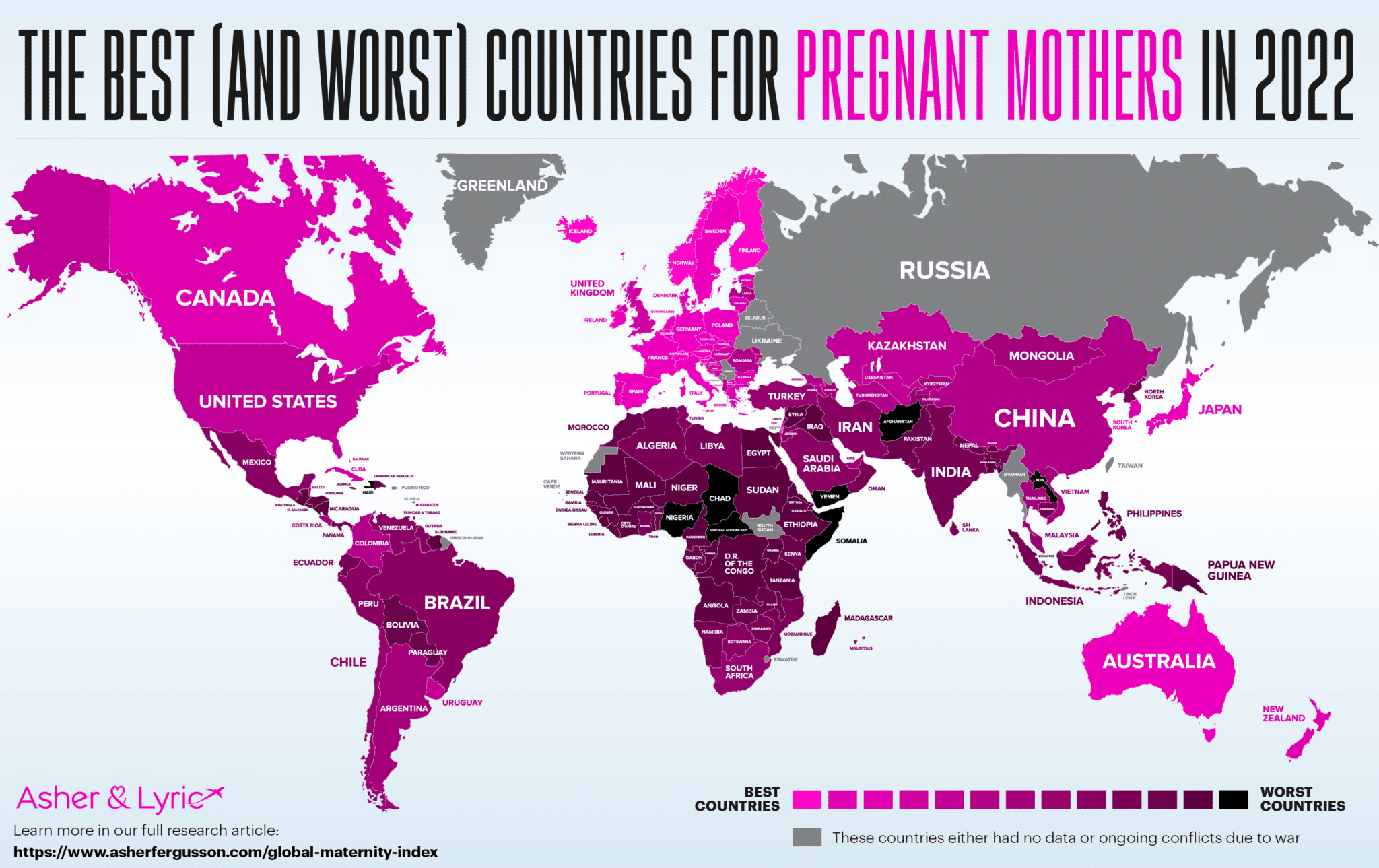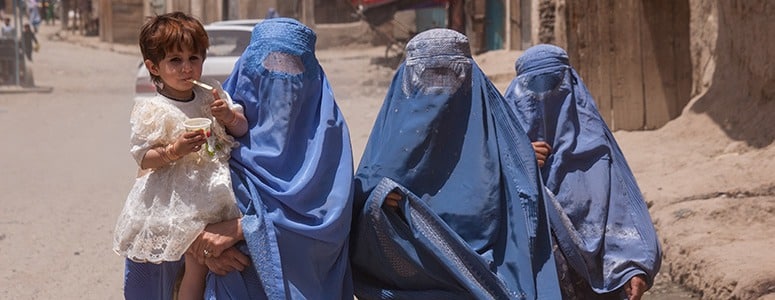Let’s take a closer look at the seven factors used to determine which countries were the best and the worst for pregnant mothers and some of the countries that ranked at the top and bottom for these important factors.
Number of nurses and midwives
An essential aspect of pregnancy is having enough support from the nurses and midwives who will be there for you before and during the delivery, especially if complications should arise or in the event of high-risk pregnancies.
Countries with the highest numbers of nurses and midwives per 1,000 people
- Finland: 22.3
- Belgium: 20.1
- Norway: 18.4
- Switzerland: 18.3
- Ireland: 18.0
- Iceland: 16.8
- United States: 15.7
- Germany: 14.2
- Australia: 13.1
- Luxembourg: 12.2
Countries with the lowest numbers of nurses and midwives per 1,000 people
- Somalia: 0.1
- Chad: 0.2
- Niger: 0.2
- Central African Republic: 0.3
- Madagascar: 0.3
- Equatorial Guinea: 0.3
- Benin: 0.3
- Afghanistan: 0.4
- Angola: 0.4
- Haiti :0.4
Pregnant women receiving prenatal care
Prenatal care is critical to ensuring a healthy pregnancy. 23 countries indicate that 100% of their pregnant mothers receive prenatal care. Those countries are:
- Finland
- Slovenia
- Sweden
- France
- Germany
- Austria
- Spain
- Ireland
- Portugal
- Lithuania
- Canada
- Turkmenistan
- Armenia
- China
- Malta
- United Arab Emirates
- Fiji
- Kyrgyzstan
- Grenada
- Kuwait
- Dominica
- North Korea
- Bahrain
Many high GDP countries and OECD countries do not release their rates of prenatal care. Countries that do not report their percentage of pregnant women receiving prenatal care are Belgium, Norway, Switzerland, Iceland, Luxembourg, Israel, Japan, Netherlands, Denmark, United Kingdom, South Korea, Croatia, Poland, Hungary, Singapore, Bulgaria, Mauritius, and Greece. We could not find a reason why these countries fail to report this metric.
UNICEF reports that globally only 60% of women are estimated to receive at least four prenatal medical visits. The World Health Organization recommends at least eight prenatal medical appointments for a safe pregnancy. UNICEF also states that areas with the highest maternal mortality also have fewer prenatal care visits.
Countries with the lowest percentages of women receiving prenatal care
- Somalia: 31%
- Central African Republic: 52%
- Chad: 55%
- Yemen: 60%
- Afghanistan: 65%
- Nigeria: 67%
- Ethiopia: 74%
- Bangladesh: 75%
- Papua New Guinea: 76%
- Vanuatu: 76%
Total births attended by skilled health staff
Having qualified medical care at the birth of a child is an important step in ensuring that both mother and baby are well taken care of. While 59 countries have 100% of their births attended by skilled healthcare staff, many still do not.
Countries with the lowest percentages of births attended by skilled health staff
- Chad: 24%
- Ethiopia: 28%
- Somalia: 32%
- Eritrea: 34%
- Niger: 39%
- Central African Republic: 40%
- Haiti: 42%
- Nigeria: 43%
- Yemen: 45%
- Guinea-Bissau: 45%
Infant Mortality Rate and Maternal Mortality Rate
While the birthing process can be dangerous, countries that offer the best care before, during, and after childbirth will often have the lowest infant and maternal mortality rates. We collected the rates of both of these unfortunate factors from the CIA’s World Factbook; the numbers of maternal deaths are per 100,000 live births, and infant mortality is per 1,000 live births.
Countries With the Lowest Rates of Infant Mortality per 1,000
- Slovenia: 1.5
- Singapore: 1.6
- Iceland: 1.7
- Japan: 1.9
- Finland: 2.2
- Norway: 2.3
- Czech Republic: 2.4
- Sweden: 2.5
- Portugal: 2.5
- South Korea: 2.9
Countries With the Highest Rates of Infant Mortality per 1,000
- Afghanistan: 106.8
- Somalia: 88.0
- Central African Republic: 84.2
- Niger: 68.1
- Chad: 67.0
- Sierra Leone: 65.3
- Gambia: 65.0
- Equatorial Guinea: 63.3
- Mozambique: 63.0
- Democratic Republic of the Congo: 62.6
Countries With the Lowest Maternal Mortality Rates per 100,000
- Norway: 2
- Poland: 2
- Italy: 2
- Finland: 3
- Czech Republic: 3
- Greece: 3
- Israel: 3
- United Arab Emirates: 3
- Iceland: 4
- Sweden: 4
Countries With the Highest Maternal Mortality Rates per 100,000
- Chad: 1,140
- Sierra Leone: 1,120
- Nigeria: 917
- Somalia: 829
- Central African Republic: 829
- Mauritania: 766
- Guinea-Bissau: 667
- Liberia: 661
- Afghanistan: 638
- Cote d’Ivoire: 617
Prevalence of Birth Defects
Every year, 8 million children are born with a serious birth defect. Countries with better living conditions, such as healthy food and clean water, were found to have fewer birth defects. See the below section about why the rates of birth defects are much higher in the MENA region.
Countries With the Lowest Prevalence of Birth Defects per 1,000 Live Births
- France: 39.7
- Austria: 41.6
- Australia: 41.7
- Switzerland: 42.5
- Italy: 43.2
- Spain: 43.4
- Finland: 43.8
- Germany: 43.8
- United Kingdom: 43.8
- Belgium: 44.6
Countries With the Highest Prevalence of Birth Defects per 1,000 Live Births
- Sudan: 82.0
- Saudi Arabia: 81.3
- Benin: 77.9
- Burkina Faso: 77.0
- United Arab Emirates: 75.9
- Tajikistan: 75.2
- Iraq: 75.2
- Kuwait: 74.9
- Afghanistan: 74.9
- Oman: 74.8
Weeks of Maternity Leave
When comparing the number of weeks of maternity leave offered to new mothers, the United States, Suriname, and Papua New Guinea were at the bottom of the list, offering zero weeks of maternity leave, The United States is the only nation on the list of the world’s richest countries to not offer any federally-mandated maternity leave.
Countries with Highest Rates of Maternity Leave in Full-Paid Week Equivalent
- Bulgaria: 52.2
- Macedonia: 39
- Albania: 32.3
- Croatia: 30
- Greece: 26.6
- Bosnia and Herzegovina: 26
- Venezuela: 26
- India: 26
- Pakistan: 25.7
- Slovak Republic: 25.5
Countries with Lowest Rates of Maternity Leave in Full-Paid Week Equivalent
Nine countries do not report mandatory maternity leave (Palau, Tonga, Democratic People’s Republic of Korea, Tuvalu, Maldives, Samoa, Bhutan, Micronesia, and Liberia). Below are the lowest rates of maternity leave for countries that report a mandatory minimum.
- Papua New Guinea: 0
- Suiname: 0
- United States: 0
- Tunisia: 2.7
- Solomon Islands: 3
- Paraguay: 4.5
- Syria: 5
- Saudi Arabia: 5
- Nigeria: 6
- Haiti: 6
Countries with the best access to safe and legal abortion
Each country approaches the topic of access to abortion differently. Many countries have full access to abortion services before a specific gestational period, often 12 weeks but sometimes more or less (“On request”). Other countries only allow abortions if the mother’s life or health is at risk. Others have access to abortion but only under limited circumstances and with a variety of conditions met (“Limited”).
Countries with the least restricted access to safe and legal abortion
- Singapore – On request until up to 24 weeks
- Colombia – On request until up to 24 weeks
- Iceland – On request until up to 22 weeks
- Netherlands – Gestational limits vary – approximately 22 weeks
- New Zealand – On request until up to 20 weeks
- Sweden – On request until up to 18 weeks
- Maldives – On request until up to 17 weeks
- France – On request until up to 16 weeks
- South Korea – On request up to 14 weeks or up to 24 weeks for specified reasons
- Vietnam – Gestation limits vary – typically up to 18 weeks
Special mention goes to Canada, which only received a B+ on our index but does have regions where women can obtain an abortion on request for up to 23 weeks and 6 days. However, because of regional restrictions, gestational limit variations, and unequal access to services, Canada lost some points in our rankings.
Countries with the most restricted access to safe and legal abortion
There are 19 countries where abortion is altogether prohibited: Haiti, Laos, Madagascar, Mauritania, Senegal, Sierra Leone, Iraq, Republic of the Congo, Suriname, Honduras, Egypt, Nicaragua, Tonga, Dominican Republic, Jamaica, El Salvador, Philippines, Palau, and Malta. The United States recently joined the list of federally unprotected abortions on a country-wide scale when Roe v. Wade was overturned on June 24, 2022, but with the caveat that some states will allow it.











